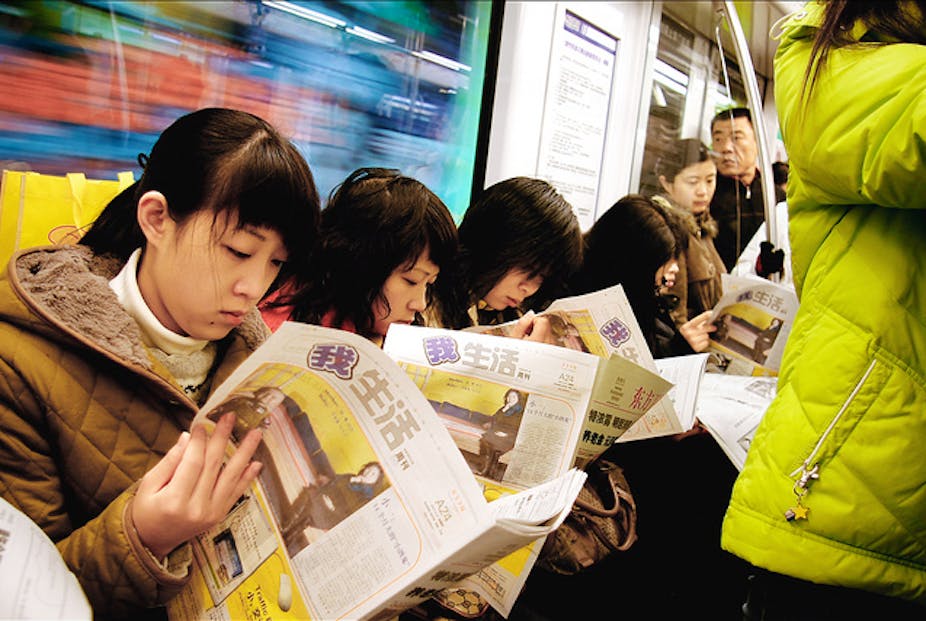There is a vast difference between how China is reported inside and outside the country. And that extends to how media and communication is taught in China and Australia.
One of my new PhD students, who is lucky enough to have a scholarship for overseas students as well as a living stipend from the Chinese government, arrived in Sydney from Beijing a couple of weeks ago.
She recently obtained a MA in Media and Communication from one of China’s key universities and is now ready to embark on a doctoral research project on the Chinese media.
At my encouragement, she has been sitting in on postgraduate classes on media and communication here (even though she is not required to) and is also eagerly going to various public talks and research seminars on a number of campuses on a wide range of topics on China, especially the Chinese media.
She has also started to read English-language academic books and papers on media and communication.
Only one week into her reading, at our first supervisory meeting, she remarked, “It seems that media and communication are taught very differently here from China. Here, your research has to focus on tensions, conflicts, and problems. In China, it is about how to improve the media industry and communication sector to promote a positive outcome”.
I was suitably impressed with her astuteness, considering that she was fresh from China and hardly exposed to academic writings in English.
Last week, both she and I went to a public talk on censorship and social media in China. Afterwards she remarked, “It’s kind of weird. Since I arrived, I have been going to classes and talks like this. People seem to be very interested in censorship and internet control in China. I know what they say is all true – I experience it myself – and we criticise it all the time, but I still feel a bit uncomfortable with someone else criticising my country. Why do they always focus on the dark side of China?”
Get your money’s worth
This reminds me of an interview I did last year with a full-fee paying Chinese journalism student in Sydney.
As part of her assignment for a subject, she interviewed Frank Moorehouse, a well-known Australian writer, about his refusal to visit China as a protest against China’s treatment of political dissident Liu Xiaobo.
At the end of the interview, she asked Moorehouse if he had any advice for her when she goes back to China. He advised her to fight for freedom of expression and democracy, or something similar to that.
She then came to interview me and asked the same question. I said that if she paid full fees she should make sure to get her money’s worth.
This means that she should use her time in Australia to learn how and why media operates differently in Australia and China. I also advised her to try to understand that Australian media works with just as many constraints and ideological agendas as the Chinese media, and she should use her time here to develop a critical language with which to describe and explain the differences and even similarities between the two systems.
Then she can go back to China and decide what she can do to make the most of what she has learned in Australia.
Teaching and learning
I am telling the stories of these two Chinese graduate students here to illustrate how we need to reassess the way we teach media to our home, and international students.
What Chinese students in Australia are going to learn is not just a body of knowledge consisting of technological and technical know-how. They are acquiring a new way of understanding media ethics, the relationship between media, market and state, and the role of media and communication in society.
They are also picking up a new language with which they can communicate that understanding. The challenge, needless to say, is enormous.
But I have no doubt that many of these Chinese students are young, open-minded, and eager to learn, and they will rise to the challenge.
However, I would like to see more evidence of media and communication educators in the Australian tertiary education system showing equal capacity to meet the challenge.
An international education
While the influx of international students to Australian universities has injected much needed income into the cash-strapped tertiary sector, the question of how best to deal with the linguistic, cultural, and teaching issues posed by cross-cultural difference in the classroom, the lack of internationalisation in the curriculum, and the prevalent assumption of an objective and free – hence superior – Western media practice remains largely unexplored.
Having taught graduate courses in media studies in a couple of universities in Australia, I have come to realise that although some overseas students have difficulty expressing themselves with confidence in English, their knowledge of how media is practised and taught outside Australia may be of value to local Australian students as well as their lecturers.
My recent conversations with a number of colleagues in the field have often gravitated towards these very issues, and have given me hope that one day in the near future, teaching media in an increasingly international classroom will become a two-way street. And the question of how to provide quality education in media to our international students will soon be put on the research agenda.

